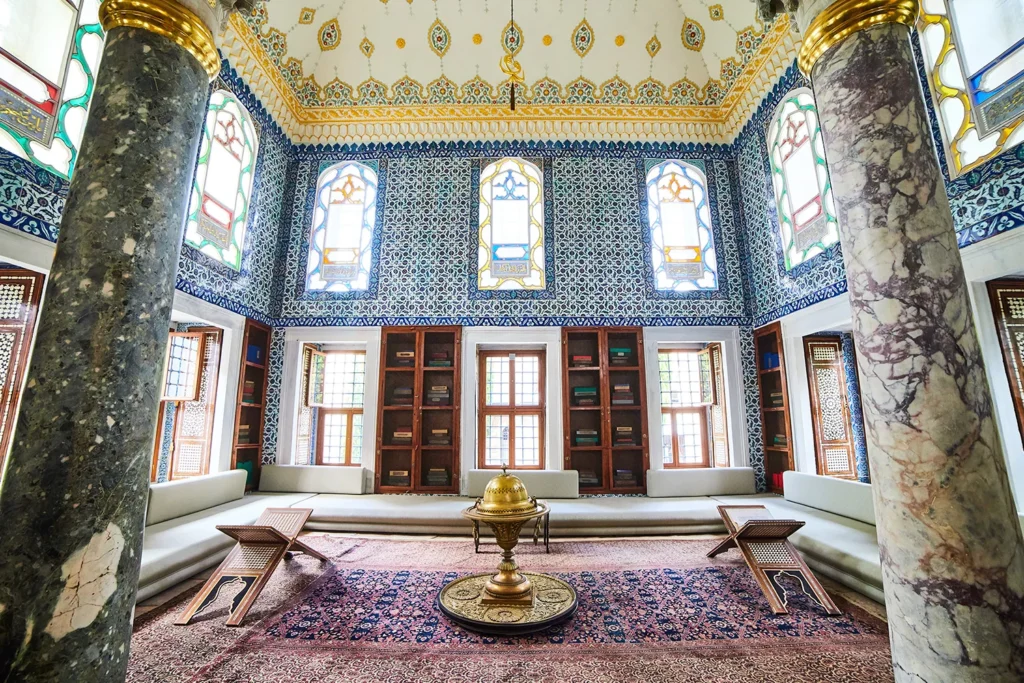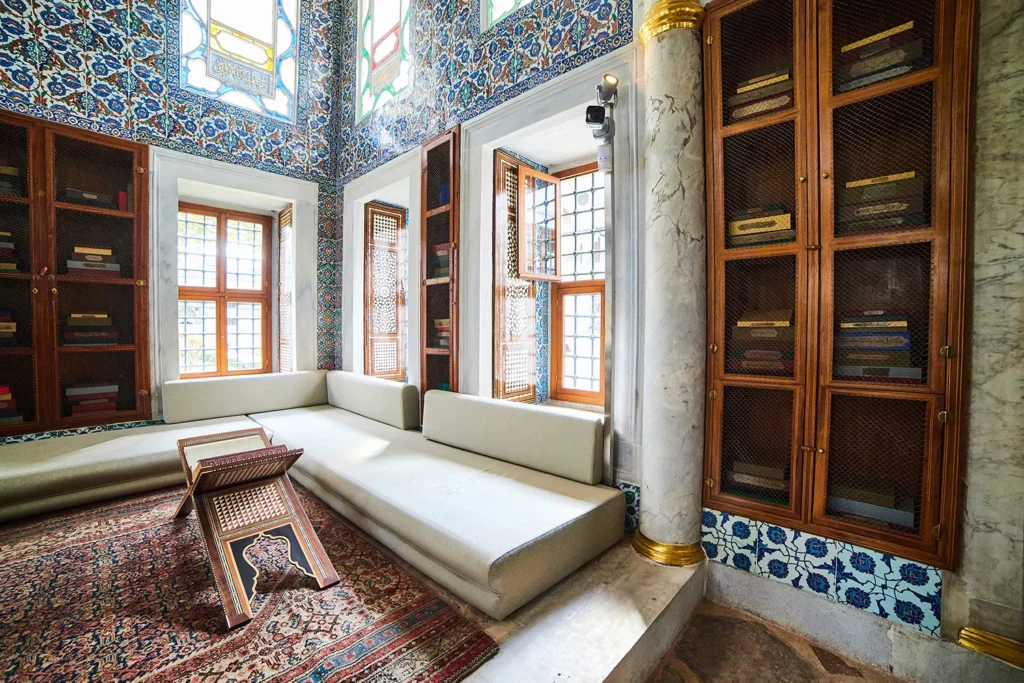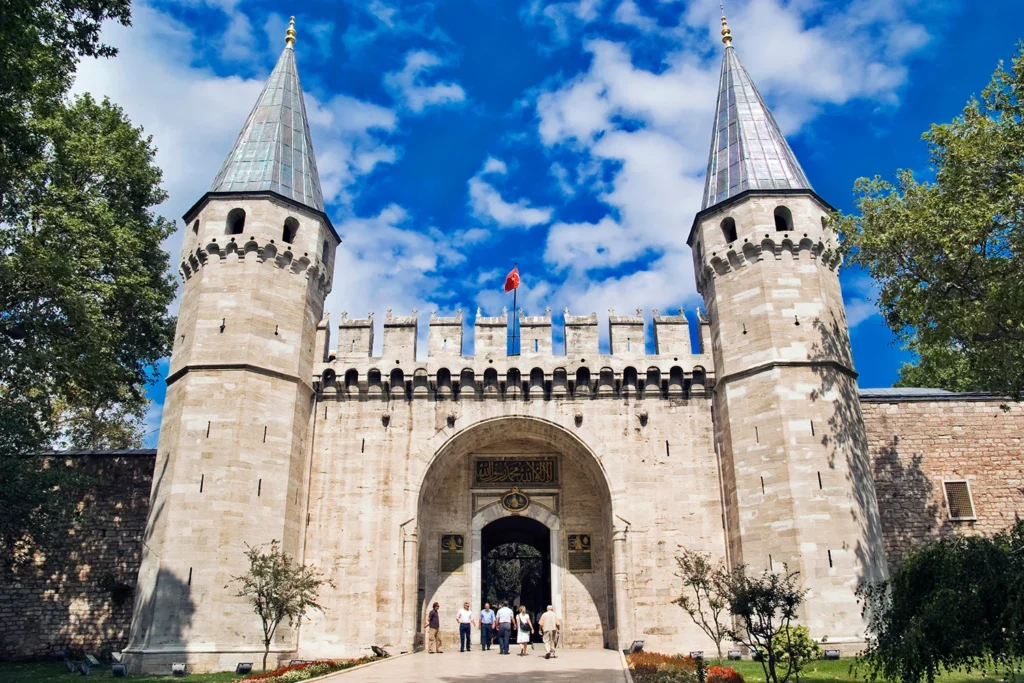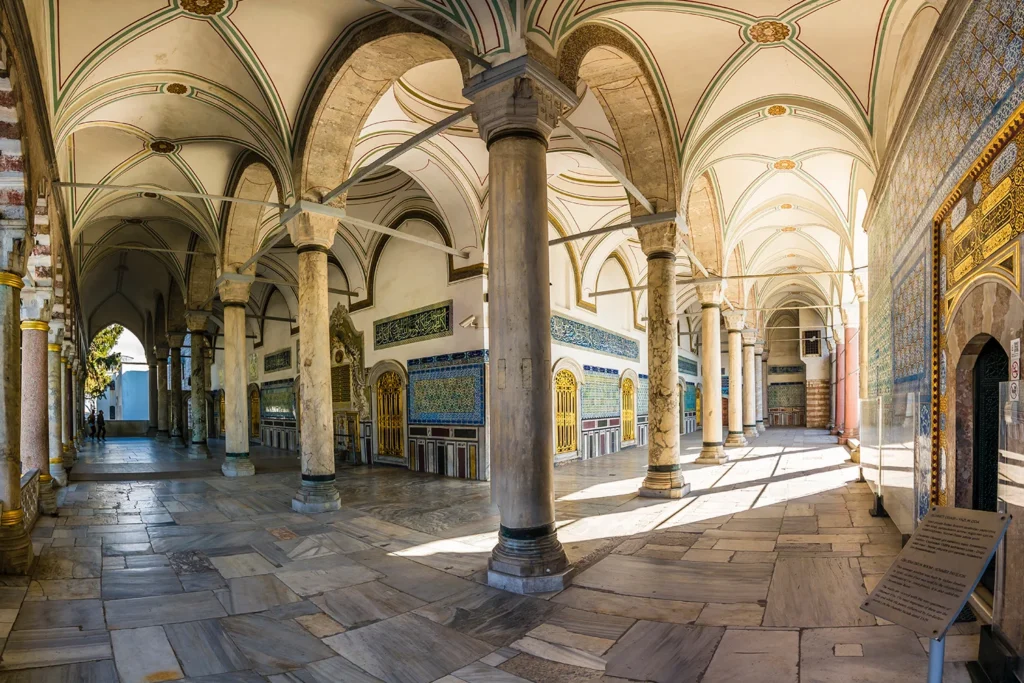Among the numerous attractions in Istanbul, there is a place that hides within its pavilions stories straight out of the One Thousand and One Nights.
Topkapi Palace, located in the heart of Istanbul, served as the residence of the sultans of the Ottoman Empire for nearly 400 years. This Ottoman-style complex is now considered the finest representation of Turkey’s rich imperial history, showcasing stunning architecture and unique traditions.
A walk through the sultans’ residence won’t be brief, as Topkapi Palace spans an area of approximately 700,000 m². Visitors are advised to dedicate at least 4 hours, if not an entire day, to explore it fully. However, the size doesn’t deter too many tourists, as the Topkapi Palace Museum is almost as popular as Istanbul’s iconic Hagia Sophia and the Blue Mosque.
The History of Topkapi Palace
May 29, 1453. This date is likely familiar to anyone who paid attention during history lessons. With the capture of Constantinople by Mehmed II the Conqueror, the Byzantine Empire fell, the Middle Ages came to an end, and, symbolically, Istanbul was born. More importantly for us today, the establishment of a new capital for the Ottoman Empire marked the first step in the decision to build a new, impressive palace.

Construction began in 1453, and Mehmed II lived there until his death. However, the palace’s story doesn’t end there—it truly begins to unfold. The building served as the administrative center and residence of successive Ottoman sultans for nearly 400 years, until the 19th century. In 1853, Sultan Abdulmecid decided to move his residence to the modern Dolmabahce Palace on the shores of the Bosphorus. This event marked the end of Topkapi as the sultans’ residence, but less than 70 years later, the era of the Topkapi Palace Museum began, commemorating the grandeur of the imperial era.
FUN FACT: The name “Topkapi” literally means “Cannon Gate,” referring to the cannons that guarded the palace from the sea. However, this name was only given to the palace in the early 19th century. Previously, it was simply known as the “New Palace.”
Palace Courtyards
The palace grounds consist of 4 courtyards surrounded by high walls. Each courtyard served a different purpose, with each subsequent one becoming a more private area. The courtyards in question, however, have nothing in common with those found in most European palaces. Instead of a large building surrounded by greenery, Topkapi Palace resembles a royal park with scattered pavilions, palaces, treasuries, and other structures amidst paths and impressive vegetation.
First Courtyard

Passing through the Imperial Gate, which somewhat separates the palace grounds from the rest of the city, you will enter the First Courtyard. This is where the ticket offices are located, and lines form for entry into the museum section of the residence. In the past, this area was used for organizing parades and was also known as the only section of the palace open to the public.
Near the courtyard, just beyond the gate, there are several buildings, the most important of which is the former Byzantine Church of the Holy Peace, more commonly known as the Hagia Irene Church, used in the Ottoman Empire as a weapons depot. In the First Courtyard, you can also find a picturesque viewpoint offering a magical view of the Bosphorus and the Istanbul skyline.
GOOD TO KNOW: Entrance to the First Courtyard of Topkapi Palace does not require purchasing a ticket for the museum section.
Second Courtyard
Heading towards the Middle Gate, you will find yourself in the Second Courtyard, mainly used for conducting business and hosting ceremonies. This is where court members and other formal guests would gather. In the Second Courtyard, you will also find the Imperial Council Chamber, where state and imperial matters were discussed, and the entrance to the Harem.
On the right side of the entrance, you will also find the barracks, audience halls, and most importantly, the palace kitchens. It is these kitchens that will reveal the secrets of royal meals and tell stories about the traditions related to their preparation. Moreover, tucked away in the kitchen areas are several pieces of Chinese celadon porcelain, valued by the sultans not only for its beauty but also because it was said to change color when in contact with poisoned food.
FUN FACT: In Ottoman times, only the sultan and his mother were allowed to pass through the Middle Gate on horseback. Everyone else, including the grand vizier, had to dismount and enter the Second Courtyard on foot.
Third Courtyard

Many voices claim that behind the Gate of Felicity lies the most fascinating of all the courtyards. The Third Courtyard, the innermost one, was guarded by the highest-ranking servants, known as the white eunuchs. It housed the private residence of the sultan and the Imperial School, where boys serving the sultan were taught music, painting, and calligraphy. Key rooms here include the Audience Chamber, where court ceremonies took place, and the Library of Ahmed III. The Third Courtyard will also lead you to the imperial treasury, where you’ll be awestruck by precious vessels, ancient weapons, diamonds, and emeralds.
However, the highlight of this courtyard is likely the Sacred Trusts Pavilion. The rooms, adorned with dazzling Iznik tiles, hold many relics, such as the cloak made by the wives of Muhammad and the sword of the prophet David. In this sanctuary, it is important to maintain reverence and refrain from taking any photos, as these halls are considered holy by Muslims.
Fourth Courtyard
The Fourth Courtyard takes the form of a grand garden, where numerous pavilions can once again be found. However, this time, it served solely as a place of pleasure and relaxation for the sultan and his closest companions. One only needs to gaze at the panoramic view of the city from one of the terraces to understand why this area was chosen as a retreat.
This space is filled with greenery, terraces, and kiosks, which are decorative pavilions typical of the architectural style of that era. You can find a special room used for circumcisions, the Tulip Garden, and two intricately decorated kiosks – the Baghdad Kiosk and the Yerevan Kiosk, which commemorate the victorious battles of Murad IV. However, the most famous element of this courtyard is the gold-adorned İftar Pavilion. In the past, this was the spot where the sultan would break his Ramadan fast after sunset. Today, the golden canopy is one of the most popular photo spots for tourists.
Imperial Treasury
This section of the palace, comprising four rooms, will transport you to a space reminiscent of a treasure cave straight out of an Aladdin tale. You’ll even find several vessels resembling the genie’s lamp. The royal treasury displays a vast collection of items crafted or adorned with gold, silver, rubies, emeralds, pearls, and diamonds. While all the treasures are worth admiring, there are a few that particularly stand out.

You certainly won’t pass by indifferently when you see Suleiman the Magnificent’s jewel-encrusted sword or the exceptional 86-carat Kasıkçı Diamond. The sparkle in some eyes might also be drawn to Ahmed I’s pearl-inlaid throne and the famous Topkapı Dagger, whose hilt is adorned with three massive emeralds. Fans of classic cinema may recognize the dagger, as it was the object of a heist in Jules Dassin’s 1964 film “Topkapi.”
It’s worth dedicating ample time to this area and taking in the exhibits, as photography is prohibited, meaning the images of these precious treasures can only be stored in your memory.
The Harem
Contrary to the popular yet somewhat erroneous belief, the Harem is often imagined as a place where the sultan indulged in debauchery and carnal pleasures. In reality, the Harem simply refers to the private quarters occupied by the emperor’s family—his children, mother, women, wives, and concubines. This section of the palace also functioned as a school in earlier times. Only the sultan, his women, children, and some harem guards, known as eunuchs, were allowed entry.
NOTE: Entry to the Harem requires a separate ticket.
The private complex attached to the Topkapi Palace consists of over 300 rooms spread across six floors. Only one of these levels is open to visitors, but even so, a separate ticket is required to explore the Harem. It’s the only way to gain insight into the private lives of the sultans and their families. Inside the Harem, you can visit the private Chamber of Murad III, lined with precious İznik tiles, or the luxurious apartments of the sultan’s mother. The Imperial Hall with its throne, still the centerpiece of the room, is particularly noteworthy. This hall was primarily used for entertaining the entire Harem.
Visiting Topkapi Palace
The best idea is to arrive at the palace gates early in the morning. This is the only way to avoid the heat and long security lines, while also giving you enough time to explore all the areas of the palace open to visitors. As with most popular attractions, the best option is to purchase tickets online. This ensures that you can enter the complex on your chosen day and time (without having to wait in the ticket line). All the tickets you’re interested in can be purchased through services like this one.
The Topkapi Palace Museum offers audio guides for those who prefer a more independent tour. However, you can also opt for the company of a knowledgeable guide. A guided tour will undoubtedly be more special, as it ensures you won’t miss any colorful stories about the lustful sultans, cunning courtiers, and beautiful concubines. Remember, though, that a regular admission ticket won’t grant you entry to the Harem. Visiting this section of the palace requires an additional fee and is only possible with an official guide.
Practical information
- It is best to purchase tickets for the Topkapi Palace in Istanbul in advance. This way, you can avoid standing in long lines and reduce the risk of tickets being sold out.
- Address: Cankurtaran, 34122 Fatih/İstanbul, Turkey
- Buy tickets on GetYourGuide